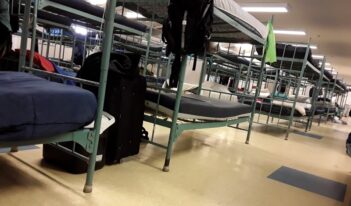
Scholars examine regulatory solutions to combat youth homelessness.
In the United States, a staggering 2.5 million children go to sleep each night without a home to call their own. The latest national data indicates that 1 in 41 school age students and 1 in 18 children younger than six experience homelessness annually, with rates more prevalent among children of color.
With the national moratorium on evictions due to COVID-19 no longer in place, the threat of homelessness due to poverty, unaffordable housing options, and unemployment looms large. This instability causes considerable trauma for young people, triggering a host of negative physical and mental health conditions including chronic illness, higher blood lead content, depression, and anxiety.
Housing instability is also associated with delays in children’s cognitive and socioemotional development. The transitory nature of homelessness significantly disrupts children’s learning. Furthermore, school changes and disciplinary referrals for tardiness, absenteeism, inconsistent grooming, and falling asleep in class rank higher among homeless youth than their housing secure peers.
Despite various legislative attempts to mitigate homelessness among youth and families, the ongoing question of who should be responsible for providing assistance—and to whom— allows for gaps in resources and support. Most families who are housing insecure do not meet the U.S. Department of Housing and Urban Development’s (HUD) definition of homelessness, even if they meet definitions provided by the U.S. Department of Education or the U.S. Department of Health and Human Services (HHS). Many of these families do not qualify under the HUD definition because they are “doubled-up,” or living with others due to economic hardship. Consequently, are unable to access HUD Homelessness Assistance Programs, which provide funding to state and local governments and non-profit organizations to mitigate homelessness.
In response to HUD’s strict eligibility requirements for homelessness assistance, other programs and agencies seek to aid homeless youth with mixed success. For example, the Department of Education carries out the McKinney Vento Homeless Assistance Act, which authorizes the federal Education for Homeless Children and Youth Program (EHCY). Although the program reaches thousands, many children who qualify for assistance under EHCY are reluctant to disclose their homelessness status or are simply unaware of their eligibility. This results in students bearing the brunt of unnecessary transportation and food costs, while program providers spend program dollars on outreach instead of service provision. ECHY district liaisons also experience implementation challenges, reporting difficulty navigating the legal and logistical challenges of identifying students, preventing them from adequately addressing their students’ needs. COVID-19 and its economic effects have only exacerbated this complexity.
In this week’s Saturday Seminar, we collect scholarship examining youth homelessness and highlight proposals by experts to expand regulatory protection for children experiencing housing insecurity.
- In an article published in The Annals of the American Academy of Political and Social Science, Tasminda Dhaliwal of the Michigan State University College of Education and several coauthors evaluate the efficacy of the McKinney-Vento Homeless Assistance Act by analyzing student homelessness in Los Angeles. McKinney-Vento, they explain, requires school districts to allow homeless students to remain at their schools even if they move outside of the school’s residential boundaries. This requirement aims to minimize the amount of times homeless students have to change schools. Dhaliwal and her coauthors find that in spite of the legislation’s goals, students still experience higher mobility when they are homeless. They argue that schools need to adopt better ways of informing families of their rights under McKinney-Vento and adopt practices to monitor and follow-up with families when student transfers occur.
- In a recent study funded by HUD, Claudia Solari and co-authors from the Urban Institute and Chapin Hall at the University of Chicago examine the success of FUP and the Family Self-Sufficiency Program (FSS) and offer recommendations for better supporting youth. For example, they suggest that HUD extend the time limit for FUP vouchers—which families and youth may use to lease safe and sanitary housing in the private housing market—beyond 36 months. Doing so, they argue, would increase housing stability for youth depending on the vouchers, which would in turn help them grapple with past trauma, catch up on academic and life skills, and reach self-sufficiency. In addition, they recommend that public housing agencies help FUP youth complete their housing applications and increase their acceptance of youth as tenants.
- In an article published in the Journal of Children and Poverty, Earl J. Edwards of the Lynch School of Education and Human Development discusses whether Black students experiencing homelessness receive adequate support under the McKinney-Vento Homeless Assistance Act. Edwards contends that any benefits Black students may receive under the act are undermined by the hostile racial climates that many of them experience at school. He finds, for example, that some schools fail to identify many Black students as being homeless, which results in the students not receiving support under McKinney-Vento. Edwards argues that policymakers fail Black students by employing race-neutral language in the act, ignoring Black students’ unique experiences. He recommends that policymakers implement race-conscious language into McKinney-Vento to prevent inequitable applications of the act and adopt intervention plans to accommodate the needs of particular racial groups.
- According to the 2021 Student Homelessness Index co-authored by Dylan Waguespack and Aleya Jones of True Colors United and Gabriella Sevilla of the National Homelessness Law Center, only a few states provide adequate services and protections for youth experiencing homelessness. They recommend that states enact comprehensive policies and regulations that specify prevention, identification, and early intervention strategies, including crisis response in coordination with the federal government and tailor-made housing solutions for unaccompanied minors. They also advocate that states proactively work to end the criminalization of homeless youth by repealing curfew laws, curbing punitive approaches such as entrance to the juvenile legal system, and minimizing court involvement with youth. Instead, they contend, states should prioritize youth safety and access to diversionary supports and services.
- In an article published in the Journal of Children and Poverty, Barbara Duffield of SchoolHouse Connection examines child and family homelessness in the United states. Despite an increase in child homelessness during the COVID-19 pandemic, Duffield claims, HUD has retained an approach that prioritizes chronically homeless adults, leaving a growing number of children and families without assistance. Duffield advocates a new approach to assisting homeless children and families: one that prioritizes stability rather than HUD’s focus on temporary shelter. She suggests the involvement of agencies specializing in youth and family needs, such as HHS and the Administration for Children and Families (ACF). Specifically, Duffield argues, ACF is well poised to provide care to homeless youth, given that the agency’s existing programs are already required to provide support for vulnerable children and families. Duffield explains that ACF programs such as the Head Start program and the Runaway and Homeless Youth Act program prioritize the care of homeless children and seek to ensure stability through school enrollment and placement in transitional housing.
- LGBTQ+ youth are 120% more likely to become homeless, claims Cameron K. Ormiston of the National Institute on Minority Health and Health Disparities in an article published in LGBT Health. Ormiston argues that federal policies such as the Runaway and Homeless Youth Act (RHYA) are not adapted to properly protect LGBTQ+ youth, and furthermore, that the welfare system retains implicit bias towards cisgender individuals. RHYA funds community-based projects seeking to provide temporary shelter, care, and counseling for runaway and homeless youth. RHYA separates youth shelters by gender, Ormiston claims, which can exclude and alienate transgender youth. He provides policy recommendations to repair the invisibility experienced by LGBTQ+ homeless youth. Specifically, he suggests passing antidiscrimination laws, such as bans on conversion therapy. He also urges policymakers to fund family-based interventions and LGBTQ-inclusive school curricula, as a majority of LGBTQ+ youth become homeless due to family or community rejection.
The Saturday Seminar is a weekly feature that aims to put into written form the kind of content that would be conveyed in a live seminar involving regulatory experts. Each week, The Regulatory Review publishes a brief overview of a selected regulatory topic and then distills recent research and scholarly writing on that topic.



